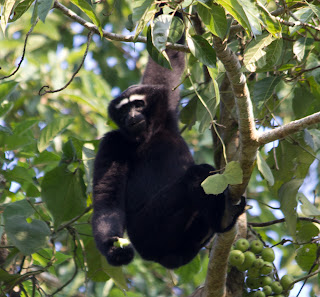 |
| Western Hoolock Gibbon |
The highlight of our trip was to be the time spent in the Kaziranga NP where there are opportunities to see many of the Indian specialities both avian and non-avian.
Early breakfast (5.30 am) was followed by a 6 am departure in two mini buses. As we left the boat a black bird was seen on top of the bridge, which we eventually decided was a Blue Rock Thrush - it did take all day for us to get to this conclusion however! Along the river we had White Wagtail, Intermediate and Little Egret, Feral Pigeon and Rufous Treepie. A Common Kingfisher was a catch up for me, having eluded my list on the previous three days.
 |
| Guarding his territory |
During the hour and a half journey we saw rural Indian life waking up with the sunrise. People watched as we continued along the journey, interested to see what we were doing. A couple of rhinoceros were feeding in a field at the side of the road - an incongruous sight for us but normal for this part of India - they were well hidden by tall grass, so we needed some better sightings.
 |
| Calling to the rest of the family |
We had two stops - one by default, where we left the other bus behind us and did some birding by the side of the road overlooking a small lake. Here we had several rhino, a pair of Swamp Deer - the male with handsome antlers, Water Buffalo, Citrine Wagtail (found when I thought I had a pipit) Rosy Pipit, yet more White Wagtail, Spot-billed Duck, Intermediate and Little Egret. At this point we got a telephone call that Gibbons had been found by the other bus, so we rushed back to find them and sure enough an obliging family of four (mum, dad, teenager and baby) were feeding on a type of fig in a tall tree by the side of the road. A great display was being put on by the male who swung from branch to branch, calling to warn any other gibbons to keep away from him and this family. As we crowded around the tree taking our photos and using binoculars to get a close-up view several locals drew up in lorries and vans to join in and marvel at the sight. They were keen to see our photos and join in our delight.
 |
| Red Junglefowl |
As we moved on, a white-throated kingfisher shot past and then perched on a tree giving great views. Common and Jungle Myna, Large-billed Crow and Red Junglefowl entertained us.
At the side of the road there were mottos painted on rocks encouraging safe driving - "if you sleep your family will weep" "life's short, don't make it shorter". I just wish I could have noted more of them.
 |
| Indian Rhinoceros |
Once we entered the park we decanted into five jeeps, with the three guides spaced at either end and the middle. We had great views of many rhinos, including one mother with young. Indian elephants were also seen well with a couple of large groups strung out across the landscape. Several had hitch-hikers in the form of egret and myna which lined up for the ride on the elephants' backs.
Back with birds - and they were not exactly falling over themselves to be seen, but we did manage to add several new species to the list including; Changeable Hawk-eagle, Crested Serpent-eagle, Asian Barred Owlet and a pair of displaying Roller. We had a great opportunity to compare heron species with Grey and
 |
| Kaziranga National Park |
Purple facing each other, then we had Great, Intermediate and Little Egret standing side by side - a brilliant comparison. Rose-ringed and Alexandrine Parakeet perched for us, and a Blue-bearded Bee-eater was seen on a branch then gave a display flight before disappearing.
Finally it was time to return to base for a rather late lunch - delayed further as we stopped to buy some local tea.
 |
| Our purpose-built Jetty |
Lunch at 2.30pm, and by 3.45 we were off again, this time for a short walk along the side of the river from the boat. Not much to report, although we did hear Lineated Barbet and saw Blue Rock Thrush (this confirmed the bird off the boat first thing) and Whistling Thrush.
As everything was covered in dust from the jeep ride, it was great to get a shower and relax before dinner.






